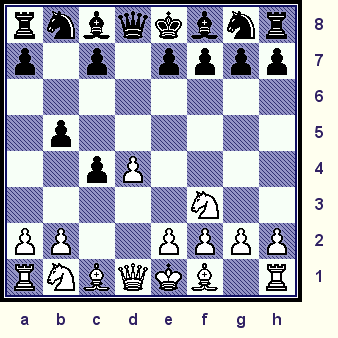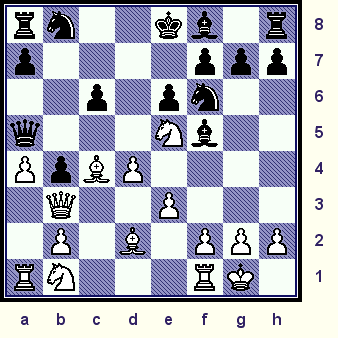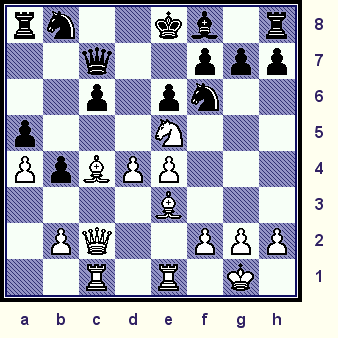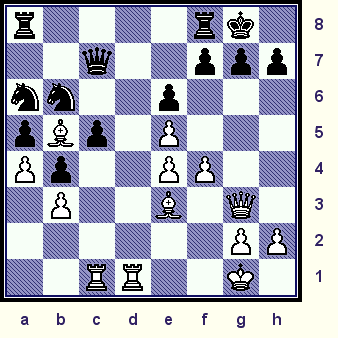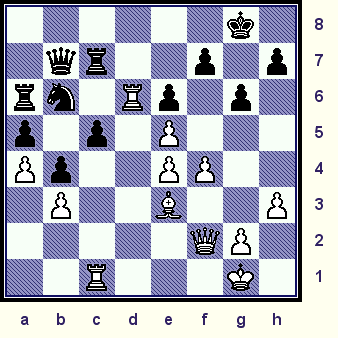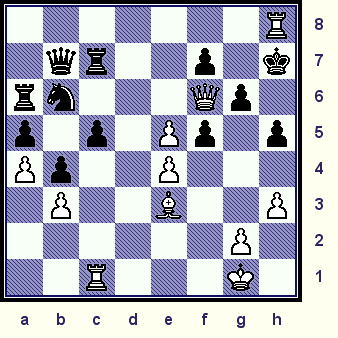All
the |
(Navigation bar
directly below.)
*******
© A.J. Goldsby, 2015.
(All rights reserved.)
****************
Click HERE
to see my
Chess Items.
****************
****************
Buy a book
from Amazon.com
(And help me out as well!)
****************
Click HERE
...
to see a list of the businesses that help to sponsor all of
my chess efforts.
A.J.
Goldsby I - Valerie Hodgson;
Played in Alabama in 2009.
One of my tournament contests - a chess game; annotated for your
enjoyment.
(I also hope that you will learn something from this game.
I have gone to great pains to make this a chess lesson for the average player.)
My students tell me - on a nearly constant basis - that my games are good and that I should post more of them on the Internet. I showed this game (recently) to a new student at the Pensacola Chess Club, and he was of the opinion that I should make a web page out of it. (As I have with so many other games.) Actually, I had been planning to make a web page out of this game ... for a long time, I just never got around to it. (April, 2011)
Another reason that I wanted to make a web page for this game was purely analytical. I had always heard masters say that Black could not (should not) try to hang onto the (QGA) Pawn. However, PROVING this to be an absolute fact ... was somewhat problematical. Now that chess engines have become so powerful, demonstrating that any Black attempt to hang onto the Pawn results in a bad position for the second player ... is simply a matter of running down all the variations.
A.J. Goldsby (2200) - V.
Hodgson (1500)
|
|
|
rnbqkbnr/p1p1pppp/8/1p6/2pP4/5N2/PP2PPPP/RNBQKB1R w KQkq b6 0 4
I
had an additional reason for annotating this game. My students - when I try to teach
them the Queen's Gambit -
always seem overly concerned about the second player attempting to keep the Pawn on c4.
(The analysis of this game should
convince you that White has nothing to fear.)
[ The (old) main line would be:
3...Nf6; 4.e3 a6; 5.Bxc4 e6;
6.0-0 b5; 7.Bb3 Nbd7; 8.Qe2 Bb7; 9.Rd1,
"+/=" (etc.)
See any good opening book for more details on this line.
(I like Nunn's and MCO-15. ECO is also good, but for five
volumes + DVD/CD's; you had better
be a pretty serious player.)
For details, see MCO-15, the analysis of the Q.G.A. begins on page # 449. ]
4.a4 c6; 5.e3 Qa5+!?; ("?!" or "?")
This is very bad - however - my opponent seems to like it.
[She found this with an old DMP computer (a small table-top box, like Novag, Fidelity, Kasparov
or Mephisto) ...
and was under the {false} impression that the move is good for Black.]
[ An actual book line is: 5...a5!?; 6.b3!? cxb3;
7.axb5 a4;
8.Nc3, "+/" ("Plus-over-a-line")
with a wild position.
See the game: Tatiana Kostiuk (2270) - Andrey A. Ivanov (2321) [D11]
Caissa CC /
Kharkov, RUS; (R#11) / 09,05,2000.
(Black won an interesting game, 0-1 in only 27 {total} moves.);
**********************************************************************
A "book" trap ... ... ... (with some computer analysis) is:
5...a6?!; 6.axb5! cxb5; 7.b3! cxb3;
Several engines consider this to be pretty much forced here for White.
***** ***** ***** ***** ***** ***** ***** ***** ***** ***** ***** *****
(Several players have suggested that Black could transpose to a form
of the "Noteboom" System with:
7...e6; 8.bxc4 b4; 9.Ne5!, "+/" ("Plus-over-a-line")
however, deep computer analysis shows a clear edge for White ...
in many lines, White even wins at least a pawn out of the opening.).
***** ***** ***** ***** ***** ***** ***** ***** ***** ***** ***** *****
8.Bxb5+! Bd7; Forced!?!?
(Not </= 8...axb5??; 9.Rxa8, +-)
9.Bc4! Nc6; 10.Bxb3, "+/" ("Plus-over-a-line")
White has regained the Pawn ... with the much better position.
(Several chess engines consider White's position to be nearly a won game here.)
]
6.Bd2 b4; 7.Bxc4, "+/=" (Maybe
'±' here)
White is already better. (Much better.)
[ Another idea was: 7.Ne5!?, here. (Hoping for 7...c5?; 8.Qf3! "+/-") ]
7...Bg4!?; 8.Qb3!,
This hits f7 and b4 ... and forces Black's reply.
(Fritz confirms that it is the best and the most active move for White.)
[ Also good was: 8.h3!? ]
8...e6[]; Forced.
(Any other move would allow White to capture on f7 or b4.)
9.Ne5! Bf5; 10.0-0 Nf6; {See
the diagram - just below.}
White has a good position ... but how to continue?
|
|
rn2kb1r/p4ppp/2p1pn2/q3Nb2/PpBP4/1Q2P3/1P1B1PPP/RN3RK1 w kq - 0 11
11.Na3!,
This is a sneaky way to get the Knight in the game.
(Of course a capture on a3 is impossible, as Black would drop the Queen.)
If Black is not careful, White will soon just "gang up" on the b-Pawn ... and then win it.
[ I also considered: 11.f3, "+/" ("Plus-over-a-line") ]
11...Nd5; (Hmmm.)
This looks like a fairly natural move here for Black. However, the box's response shows that it is probably less than best.
[ The metal monster offers the following improvement for Black:
>/= 11...Qb6!; 12.a5! Qxa5!?;
13.Nc2 Bxc2; 14.Qxc2 Qc7;
15.f4 Bd6 ; 16.e4, '~' ("comp")
and White has very good play. (Probably more than enough for the one-pawn-minus here.)
-- Analysis by Fritz 12. ]
12.Rfe1 Qb6; 13.Nc2 Bxc2;
Black is in a bad way - the machine confirms that my opponent may already have a hopeless position. (Yet the material remains equal - for a very long time after this point in the game.)
[ The box - give the following line as being the best:
13...Be4; 14.a5 Qc7;
15.Bd3 Bxd3; 16.Nxd3 Na6;
17.e4 Nf6; 18.Qc4 Qb7; 19.Ncxb4, "+/-" - Fritz 12. ]
The next few moves are easy to understand.
[According to a strong chess engine, (Fritz 12); White's play is very close to being the best move ... every time.]
14.Qxc2
a5; 15.e4 Nf6; 16.Be3 Qc7; 17.Rac1,
"+/" ("Plus-over-a-line")
('!') {See
the diagram - just below.}
(In this position - White is clearly a whole lot better.)
|
|
rn2kb1r/2q2ppp/2p1pn2/p3N3/PpBPP3/4B3/1PQ2PPP/2R1R1K1 b kq - 0 17
Now Black is stuck with a horrible backward c-Pawn. (And I am also way ahead in my development.)
[ The box likes: 17.Bg5, "+/" ("Plus-over-a-line") instead. (Also 17.h3, and 17.Qb3.) ]
17...Bd6; 18.f4 Bxe5; 19.dxe5!, Rule
violation.
(White captures AWAY from the center.)
I did this to dominate the d-file. My DSB {D.S.B. = dark-squared Bishop. Ed.} is also freed, and now - in some lines - the pawn wedge on e5, e4 and f4 will be part of a fantastic attacking force on the King-side.
[ Or 19.fxe5 Nfd7; 20.Qf2, "+/" ("Plus-over-a-line") ]
Before trying to win the c-Pawn, I (now) decide to probe Black's King-side. {Because there are almost no pieces in that part of the board. And - of course! - the King IS the most important piece on the chessboard.}
19...Nfd7; 20.Qf2! 0-0; 21.Qg3 c5; 22.Red1! Na6; 23.Bb5! Nb6; 24.b3!, {See the diagram - just below.}
|
|
r4rk1/2q2ppp/nn2p3/pBp1P3/Pp2PP2/1P2B1Q1/6PP/2RR2K1 b - - 0 24
Even the box does not "get" this move, or its long-term effects. (My a-Pawn is protected, the Black Pawn on c5 is doomed, and both of Black's Knights are rendered as completely ineffective pieces.)
[ Other tries: 24.Bxa6!? - Deep Junior; or 24.Rd6!? - Fritz 12. ]
I continue to improve my position ...
(I pile up my pieces on Black's backward Pawn, and I even find time to give my own King a little
luft ... just in case it is needed later.)
[Editor's note: I saw one line where the BQ
gave a check on the back rank, if it got to e1, it might be mate. Since
Black cannot do anything about it, I take the time to go ahead and give my
King a little "running room." While such precautions may not be
necessary, in the strictest chess sense, I am also a big believer in not
blowing a won game ... I have done this too many times in tournament play! I
would rather make a move that might not be absolutely required, than to blow
a highly favorable position.]
24...Rfc8;
25.Qf2 g6; 26.Rd6! Qb7; 27.h3! Rc7;
28.Bxa6! Rxa6;
{See the
diagram - just below.}
Black is completely tied up.
|
|
6k1/1qr2p1p/rn1Rp1p1/p1p1P3/Pp2PP2/1P2B2P/5QP1/2R3K1 w - - 0 29
To be honest, I initially captured the Knight on a6 as part of my plan to win Black's button on c5. However, there is an old saying, "When you have found a good move ... don't immediately play it. Stop and look around, you might find a much better move."
[ According to our machine friend, the move 28...Qxa6[]; was best (forced!)
... ... ...
and an improvement over the way
that the game was actually played. - Fritz 12. ]
Black's last move was actually an error,
now White has a decisive combination.
29.Rd8+!,
White decides to forget about winning the Black c-Pawn and simply goes after
Black's King. (SURPRISE!!!)
[No one watching this game - predicted what actually occurred at the end.]
[ Also good is: 29.Rxc5, "+/" ("Plus-over-a-line") ]
29...Kg7; 30.f5! exf5;
Nothing will save Black here.
[ Or 30...f6; 31.Qh4 g5; 32.Bxg5 fxg5; 33.Qxg5+ Kf7; 34.Qf6#. - Houdini 1.03a ]
31.Qh4! h5;
The best move was ...g5; here, (or even ...f4) - - - according to all of the chess engines that I have.
(See one variation - just below.)
[ Best - for Black - was - 31...f4; 32.Qf6+ Kh6; 33.Qxf4+ Kg7; 34.Qf6#. ]
32.Qf6+ Kh7; 33.Rh8#. {See
the final diagram - below.}
I consider this one of my very best games ... BUT with the following reasons or considerations:
I have always seen GM games like this. They tie up their opponent "hand and foot" (so to speak), however, the
killing blow often comes to the King, most often - in a manner that was completely unexpected.
When you add to the fact that this
game was played at such a fast pace, ("Game in 25 minutes," plus a five-second increment;)
can - IMO - only add luster to this game.
*************************************************************
The final position - in this game. (See the diagram - just
below.)
|
|
7R/1qr2p1k/rn3Qp1/p1p1Pp1p/Pp2P3/1P2B2P/6P1/2R3K1 b - - 0 33
*************************************************************
Copyright (c) A.J. Goldsby, 2009. All rights reserved.
Copyright (c) A.J. Goldsby, 2010. All rights reserved.
Copyright (c) A.J. Goldsby, 2011. All rights reserved.
1 - 0
The analysis for this page was prepared with the excellent program, ChessBase 10.0.
The HTML was polished with several different tools and programs, (mostly FP) ... the text was checked for spelling with MS Word.
The diagrams were created with the program, Chess Captor 2.25.
Do you have a comment ... on this game? Would you like to provide me with some feedback? Then feel free to send me an e-mail.
Click HERE to see the Impala Blog for/about this web page.
My
System in chess, (see all three pages be sure to follow
the links at the bottom of the pages!);
... using this was instrumental for playing this game.
Click HERE to return to my home page.
Click HERE to go/return to my "Best Games" page.
Click HERE to go/return to my "My Games" page.
Click HERE to go/return to my "Site Map." page.
This page was first prepared just after this game was played! Sometime in 2009.) It was first posted {on this website} on April 10th, 2011.
The final format was completed on Monday; April 25th, 2011 at around 11:30 PM. This page was last altered on Tuesday, June 19, 2012 05:17 AM .
Copyright (c) A.J. Goldsby I
Copyright (©) A.J. Goldsby, 1985 - 2010.
Copyright (©) A.J. Goldsby, 2011. All rights reserved.
|
|
